Classic Ride: Walna Scar Road.
Feast your eyes on some Cumbrian loveliness, courtesy of this issue’s Classic Ride.
Words by Barney Marsh, pictures by Steve Makin.
This ride has its roots in a recent stag do, during which we managed to ride (admittedly ridiculously hungover) pretty much this entire route, backwards. I am here to tell you, right now, it’s much, much better this way round.
Torver (originally ‘torf erg’, which is Norse for turf-roofed hut) is a small hamlet just south of Coniston. Things have come on a bit since the place was named, happily, and it’s a fine place to start the ride, although the buildings are disappointingly bereft of green roofs. Not only does it have an excellent pub and deli in the Wilson Arms – for pre-ride snack acquisition and post-ride thirst slaking and food inhalation respectively – but it’s also quite a lot easier to get to than the other potential starting point, Seathwaite, which also has its merits. More on these later. Andy, Chipps, photographer Steve and I park by the pub, which also has a large car park at the back. The pub is happy for folk to park there, depending on numbers, but have asked that riders please pop in to let them know before setting out – especially if you’re in a large group.
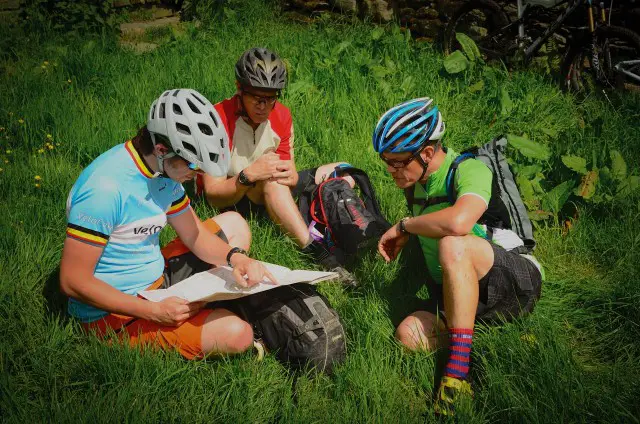
Squelch is in evidence here and there
Leaving Torver, we head south along the A593 – which really is far too minor a road to have the sobriquet ‘A’. It meanders slightly uphill: no problem for hardy adventurers like us, and we spin along chatting happily until we find Old Rake, which heads off to the right. Sharply upwards, of course. One in four. And, of course, it’s up here that we’re supposed to go. So, not yet warmed up, we groan and creak skywards. Halfway up, we notice that Steve has stopped to take photos so we all wait for him gratefully, taking the opportunity to relieve ourselves of the watery by-products of pre-ride fizzy pop and coffee. A few hundred grams lighter and reunited with our photographer, we head off again and duck into the Forestry Commission woodland that surrounds Appletree Worth Beck.
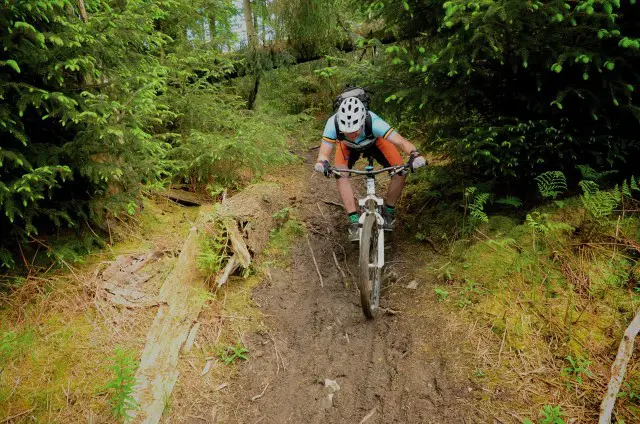
This is a pleasant surprise. Generally speaking, if you’re riding in the Lakes you know what to expect, and sinewy woodland singletrack isn’t it. But here we are. After a short fire road section, the trail drops down through a boggy stream; once over the other side, the fun really begins. Swooping and occasionally rocky singletrack, with little drops, smaller techy bits and the odd tree to limbo underneath. It is a total blast on the day we ride it. The bridleway works through the forest, occasionally joining the fire road again before ducking off under the tree canopy once more. The best bit? It’s mostly downhill. Be aware that it can get quite boggy when the weather turns inclement, although in places there is evidence that the trail has been (extremely sensitively – nice work, Forestry Commission) prepared to be good all year round. Other sections haven’t fared quite so well, however. There was a thunderstorm the day before we ride through, so squelch is in evidence here and there.
Brace yourself: here come the Dad facts…
Eventually, after innumerable photo stops, and ‘ride-that-bit-again-but-with-more-elbows-and-less-knees’ requests, the trail spits us out onto the road just south of the old farmhouse (it’s now a holiday let) of Stephenson Ground. Archaeological digs near here apparently show evidence of human occupation for four thousand years. They’ve found a Bronze Age roundhouse, a Viking longhouse and early medieval buildings. Not all at once, I suspect. Apart from the views, it’s difficult to see what medieval people saw in life here: there’s no phone signal, and there isn’t a pub for almost two miles.
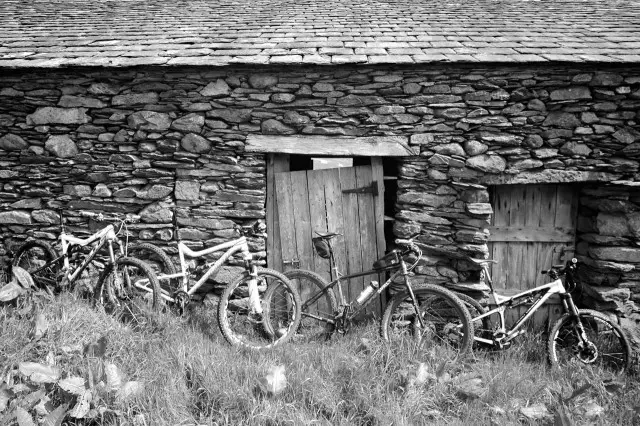
From here, there are a few options. We decide to ride along the road for a bit, exchanging pleasantries with the few walkers we see, past Jackson Ground until we find Carter Ground. It’s difficult to find out (at least just using the internet) why these ‘grounds’ are so closely grouped. Presumably it’s something to do with a land claim; Stephenson Ground and Jackson Ground were farms and Carter Ground was (according to a friendly old local we met) a tiny hamlet of four or five iron-ore mining cottages – now amalgamated into one house, a few barns and quite a lot of ruins.
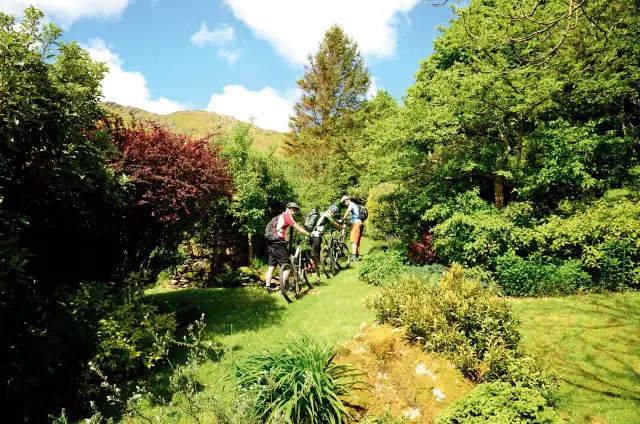
A peaceful, serene air only broken by the wheezing and grunting
After some confusion as to where the path actually goes, peering at Garmins and looking at maps, some local farmer-types drive up and tell us that the trail runs directly through the rather lavish garden of the house. Anxious not to cause offence, we dismount and walk through, admiring the flowers and greenery. It’s no exaggeration to say we feel out of place, but apparently the lady who lives there is quite friendly. We hope not in a ‘twelve-bore and a smile’ kind of way. We furtively take our bikes through the gate at the top of the garden, and continue on.
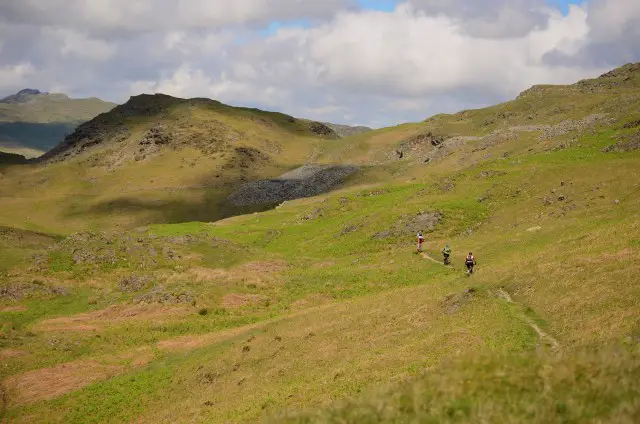
The climb from this point is more typical Lakeland riding. Exposed hillside, the odd alarmed sheep and a peaceful, serene air only broken by the wheezing and grunting of four cyclists all looking forward to the next available beer stop. It’s quite satisfying to see the top of a hill on the close horizon with only a narrow wiggle of singletrack leading to its summit, and to clean it without too much difficulty.
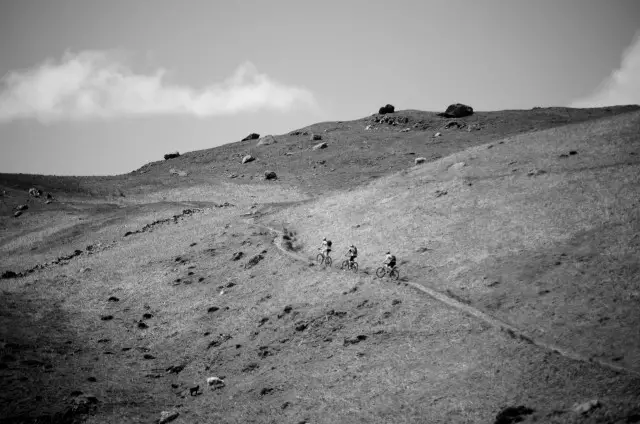
It’s rather less satisfying to look around once you’re there to see the same wiggle of singletrack heading really quite a long way into the distance, and mostly uphill. Actually, that’s not quite true. There is quite a bit of ace, slightly-downhill contouring around Raven Crag included in the deal before we climb up Park Head Road to the top of the Brock Barrow descent.
An indisputable high point.
Oh, now this is fun. Quite possibly one of my favourite Cumbrian descents, the Brock Barrow trail into Seathwaite is loose, rocky and completely fantastic. It starts off innocuously enough, and just when we’ve gathered enough speed to make the clack-clachack of stones under our wheels become deafening, we are faced with a selection of sudden corners and alarmingly steep step-downs, or a sudden change in terrain that causes a brief, sphincter-tightening, two-wheel drift before hurling us down something else chute-like.
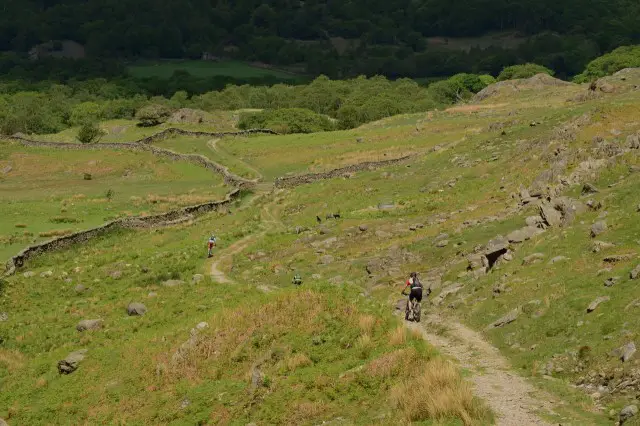
Time to exercise some self-restraint
The penalty for failure would be painful, but the fantastic thing about stuff like this is that it respects the speed at which you ride it. If you take it slowly, for the most part it’s relatively forgiving. Hit it a bit harder, and the fun and technicality increases exponentially, as the time to decide line choice is dramatically reduced. Thus, with little-boy-in-an-unattended-sweetshop giggles, we make our way into Seathwaite, and, in the glorious sunshine, stop for lunch.
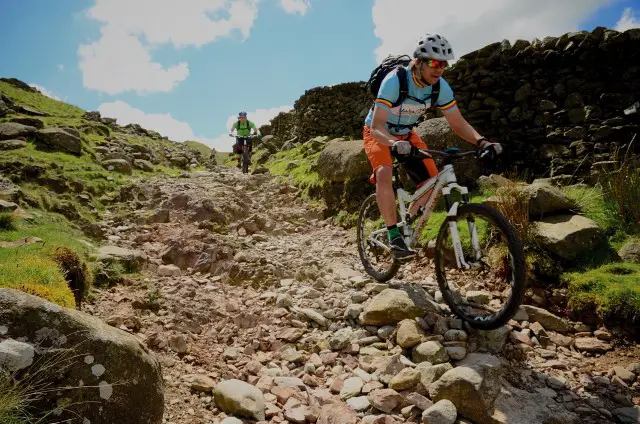
We all pile into the Newfield Inn and, despite a near miss when a particularly humorous local tells us the beer is off (we let him live), order drinks and food.
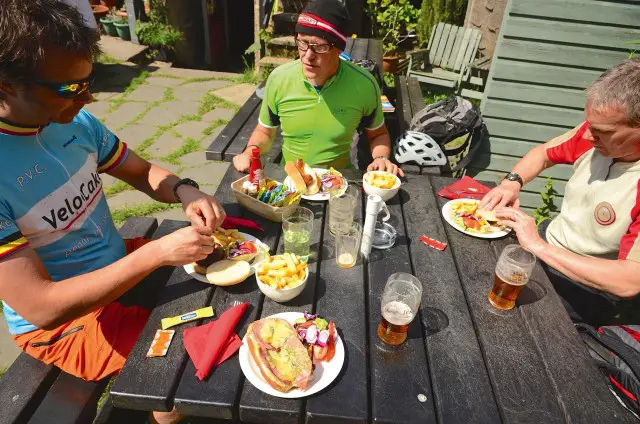
The Newfield Inn has a fantastic slate floor – this type of striped slate was once mined locally, along with the graphite for pencils, fact fans – and Chipps assures us that the B&B facilities are excellent too. So, although it’s a bit of a fiddly drive to get to, this would also be a fine place to start and finish the ride; the prospect of food and bed at the end of that fabulous descent would be extremely tempting. As a happy bonus, the Newfield Inn has Jenning’s Sneck Lifter on tap – one of the finest beers known to (this particular) man. Mmmm. Time to exercise some self-restraint.
Chemically altered.
An hour or two later, marvellously refreshed having spectacularly failed in that self-restraint thing, we pedal nervously to the start of Walna Scar Road and the frankly ridiculous sign that permits horses – and carts. I would be more than a little impressed to see a horse and cart driven with sufficient skill to negotiate Walna Scar Road. I suspect some sort of antigravity device would have to be employed, as well as some sort of horse-calming mechanism. Like ketamine.
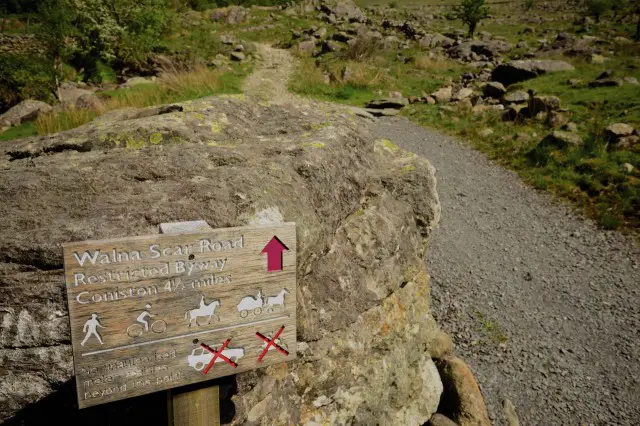
The little elephant starts to hallucinate after too much booze
The trail starts off steeply, with some loose but negotiable rocks, and some grippy bedrock in the corners. Saddle firmly lodged up fundament for optimal weight distribution (at the expense of dignity, comfortable walking and the long-term prospects of children), I make a decent fist of the first – oh, hundred metres or so. And then I look at the trail which disappears up, up, up into the distance. If you’re really fit, and you’re determined, and you’re lucky, and you’ve not been drinking Sneck Lifter at the Newfield Inn, you might be able to make it up Walna Scar Road to the saddle of the hill without dabbing. Or pushing. Or weeping bitter tears of failure and regret.
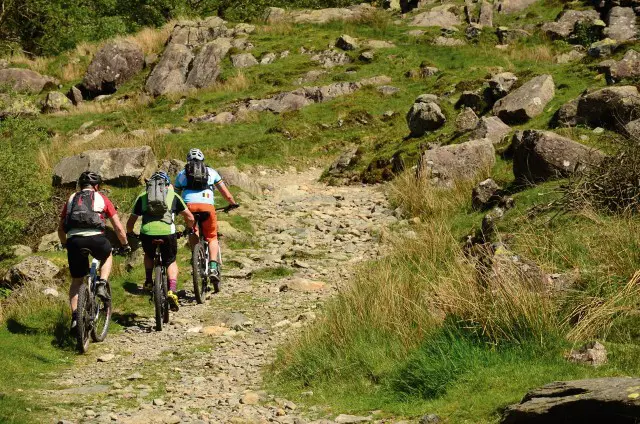
It’s quite a slog: one and a half miles or so of loose rocks, arranged carefully with their counterparts to cause maximum annoyance and minimal satisfaction. Around a third of the way up, and after the second ‘comfort’ break since leaving the pub, I repeatedly start to think the rocks I am wearily walking over (yes, yes, I know) are churning and writhing, assuming amusing shapes, before I shake my head and normality resumes. My predicament brings to mind a famous scene in Disney’s Dumbo, when the little elephant starts to hallucinate after too much booze. I can’t claim anything that dramatic, but I guess the rocks are more or less elephant-coloured. I blame the heat. Definitely not the beer.
The last hurrah.
And on, and on. And on. Brief flurries of red-faced riding for the camera turn into testosterone-charged ego massages, which turn into ignominious defeat as the large, tired, beer-numbed portions of my brain round on the (increasingly defensive) testosterone-y bits and beat them up with hewn chunks of crystalline can’t-be-arsed.
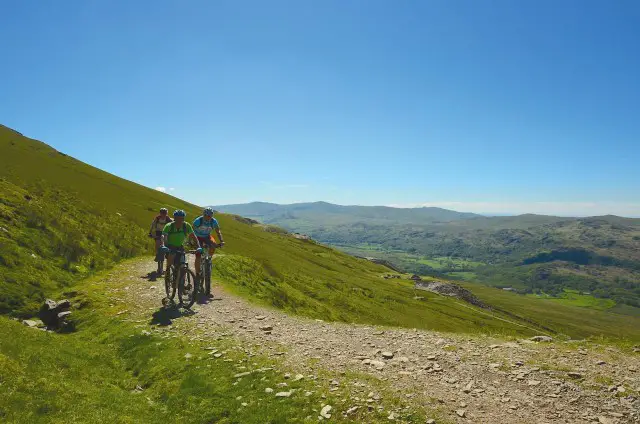
And so it is that we reach the top, and the view. Oh, man, the view! The whole valley spreads out before us: Old Man of Coniston on the left, the lake to the right and a lovely, lovely ribbon of twisty downhill stretching invitingly out before us.
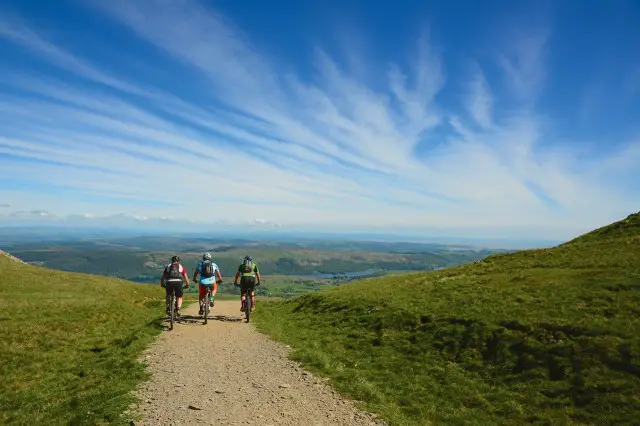
White-knuckled, teeth gritted
There will no doubt be folk who bemoan the fact that this trail was sanitised, and thus ‘ruined’, a couple of years ago. It’s not as technical as it used to be, perhaps – but after a couple of years of weathering, the top section of the descent is still an absolute hoot. Switchback after rocky, technical switchback – the same loose, skatey slate as the upside, conspiring with the underlying bedrock to force us into a variety of unwise line choices that we’re delighted to ride away from relatively unscathed. A couple of relaxed walkers coming up from Coniston look at us as we’re riding, white-knuckled, teeth gritted: “Rather you than me, mate!”
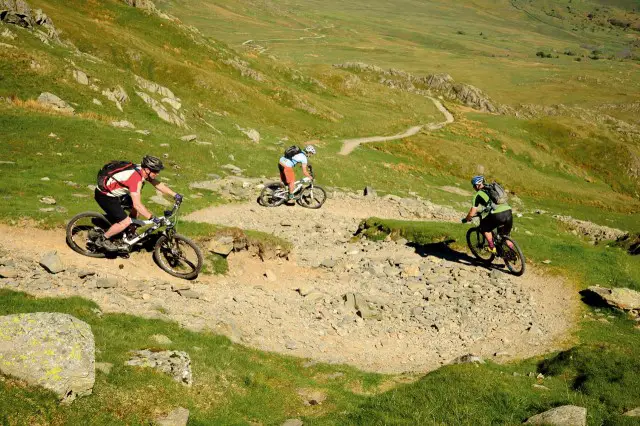
Yes. A thousand times yes!
The descent eases a little, and it’s at this point – to me at any rate – the resurfacing becomes more apparent. The trail is very, very fast, and, because of the rocks, extremely loose and treacherous under wheel. But we are only on it for a few hundred metres before we peel off to the right, down to Torver. Be careful to take the correct bridleway here: there are two that run parallel 20 metres away from each other. The one to the west (closer to the summit) is rather boggy at the top.
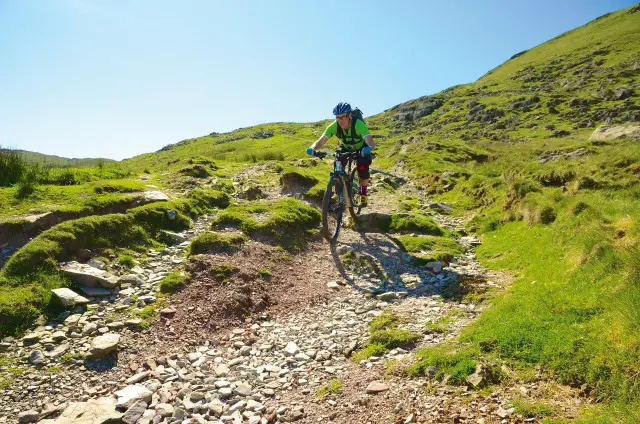
Cans of cold pop and unfeasibly large sausage rolls
For my money, the other one (over the stream, and towards Coniston) is preferable. Fast, fast grass track followed by rocks and drops, through some sort of old quarry workings, past a magnificent fenced-off hole in the ground complete with waterfall, and a final rocky lane leading inexorably down, down and into Scarr Head, dropping back into Torver, where cans of cold pop and unfeasibly large sausage rolls await us from the deli at the Wilson Arms.
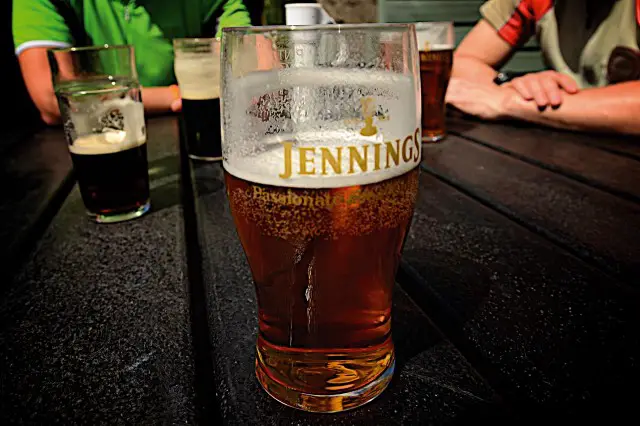
Take one colossal granite batholith. Sprinkle with other volcanic and sedimentary rocks, and leave to rest under the influence of oxygen and rainfall for several million years. Add repeated glaciation and at the very end stir in great fistfuls of quarrying. Garnish with lashings of agriculture and tourists. Ta-da! Instant Lakes.A lot of people have a very particular idea about the Lake District: The honeypot of the UK. It’s beautiful – provided you can see past the teeming throngs who pour out of coaches on every corner, cameras in hand. It’s crammed with fantastic trails – if you can pick your way through the hordes of walkers who parade, single file, through every track and bridleway in the place.There is some truth to these stereotypes. The Lakes relies on tourism – some 12 million people visit the place every year – which has superseded agriculture and industry as the mainstay of the local economy. So there are obviously points where the tourists flow like syrup – Kendal, Keswick, Windermere and Ambleside. There are obviously also places where walkers teem like ants. Principally the trails close by these towns. But the southern Lakeland fells are relatively less populous, and less popular with tourists, than their more eastern brethren. You’ll certainly encounter walkers, as you will in any National Park, but walkers and bikers rub along on these trails reasonably happily.This Classic Ride (and it certainly is a classic: if you’ve not ridden a variation of it before, you really, really should) uses trails belying the opinion that the most fun you can have is on singletrack. The excellent trail through Appletree Worth at the beginning of our ride is enormous fun, but it’s beaten roundly into submission by the two technical doubletrack descents that come after it. Although the loop isn’t particularly long, it’s still an all-day endeavour. Especially with two excellent pubs so conveniently placed on the way round. It’s also well worth staying for longer. Many, many of the trails in the Lakes are fantastic – both in the immediate vicinity of this route and further afield. If you want to make a weekend of it, there are wonderful trails in Grizedale Forest just to the east of Coniston: as well as the purpose-built North Face Trail, I strongly suggest you explore the bridleways. Be advised though: Grizedale can get busy at weekends, so an early start is recommended. The trails by the honeypot towns can be a lot of fun, too, but I prefer to tackle them midweek to ensure the number of walkers is minimised.There are many other passes and trails to explore elsewhere; generally, the harder it is to get to a location, the quieter it will be. If you fancy something a little more groomed, then Whinlatter, another excellent trail centre, is less than an hour’s drive away. In short, the Lakes are well worth a few days of your time.
- Distance: 13 miles
- Highest Point: 621m
- Total Ascent: 1,008m
Maps.
Ordnance Survey Explorer OL6: The English Lakes – South-western area’ will see you right in a 1:25k kind of way. For further Lakes exploration you’ll need OL4, OL5 and OL7 too. They’re excellent investments.
Accommodation.
- The Wilson Arms, Torver, Coniston LA21 8BB 01539 441237 thewilsonsarms.co.uk. Rooms and holiday cottages. They have a washing area for bikes, and secure bike storage.
- The Newfield Inn, Seathwaite, Duddon Valley, Broughton in Furness LA20 6ED 01229 716208 newfieldinn.co.uk. Two self-catering flats, max. four or six people respectively.
- Also try duddonvalley.co.uk for more suggestions.
Campsites.
There are inevitably loads of campsites within riding distance. Try:
- Scarr Head Campsite, Torver, Coniston LA21 8BP 01539 441576 scarrhead.co.uk Basic, quiet campsite, no groups.
- Coniston Hall Campsite, Haws Bank, Coniston LA21 8AS 01539 441223 conistonhallcampsite.wordpress.com/coniston-camping/ Groups welcome, so it can get noisy. They also have cabins.
Food during:
- The Newfield Inn, Seathwaite – as above. The half-pound burger(!) is an excellently tasty thing to regret eating halfway up the next climb. And did we mention the beer…?
Food after:
- The Wilson Arms – as above. As well as excellent food, they also have a deli on site selling the most preposterously substantial sausage rolls known to man.
- The Blacksmiths Arms, Broughton Mills, Broughton in Furness LA20 6AX 01229 716824 theblacksmithsarms.com Good food and beer.
Bike Shops.
- Biketreks, Rydal Road, Ambleside LA22 9AN 01539 431245 bike-treks.co.uk Demo and bike hire.
- Grizedale Mountain Bikes, Grizedale Visitor Centre, Hawkshead LA22 0QJ 01229 860335 grizedalemountainbikes.co.uk Also do bike hire.
A GPX file of this ride will be available in the Singletrack Mag Archive.
If you enjoyed this feature then please consider a subscription to Singletrack. Click the button below for more details.
[subscribelink]
Comments (11)
Leave Reply
Post Comment

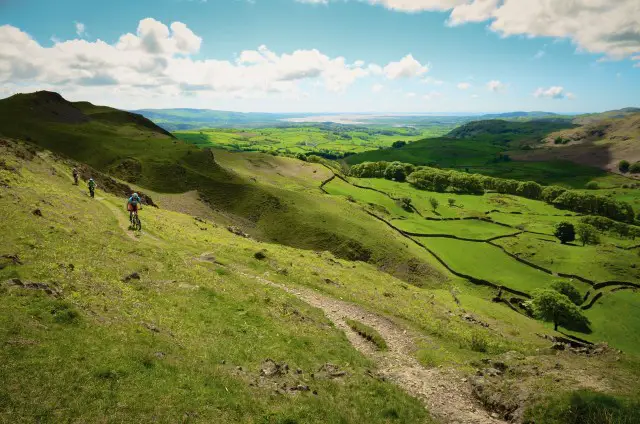

That looks marvellous.
I rode most of that during day one of our Coast to Coast epic over four days last month. The weather wasn’t as favourable for us but I’d recommend it to anyone, definitely some of the best natural trails in the UK.
You missed taking a swim in the plunge pools of the Duddon.
I’ve not ridden the Coniston side of Walna Scar since it was sanitised and have been meaning to do so for some time. Perhaps my day off in the next week could be the perfect opportunity?
One trail not mentioned is the BW heading down next to the forestry track that climbs up to meet Walna Scar from Stephenson Ground alongside the River Natty but on the opposite side. It is a hoot!
My Mag turned up this morning. Happy days!
Tomaso
The last time I road the BW up along the west side of the river (the River Lickle, leading to Natty Bridge? – at least on the OS maps) it was lots of fun – but the boggy push/carry/slog across Caw Moss and the bottom of White Pike to the Walna Scar Road was truly horrendous. So I left it out. I admit, this was *years* ago though. And besides, that leaves you without the Brock Barrow descent and the beer at the bottom. Mmmmm. Beer 🙂
Arrived this morning and reading it made me want to ride my bike 🙂
Sausage roll?!?! You mean you didn’t have a gammon egg and chips? 🙂
As a consequence of the ruination of the Coniston side of Walna Scar you can pick up a lot of speed which does you no good when you come across an abrupt and very deep V channel in the trail where a bridge was before.
Barney,
I think what Tomaso is suggesting, and which I wholeheartedly recommend, is when you get to the last fire road crossing in Broughton Moor Forest, turn right and ride up the fire road on the eastern side of the River Lickle to Natty Bridge, then descend on the singletrack on the opposite side of the river, down to Stephenson Ground.
You can then follow the bridleway round to Carter Ground, avoiding the road section entirely, and pick up the route as per the article, to enjoy the Park Head Road section to the Newfield Inn.
Best part of the world round here!
Steve – ah, that does sound tempting! I’ll give that a try next time… Can’t wait to get back and explore more – I do love the Lakes 🙂